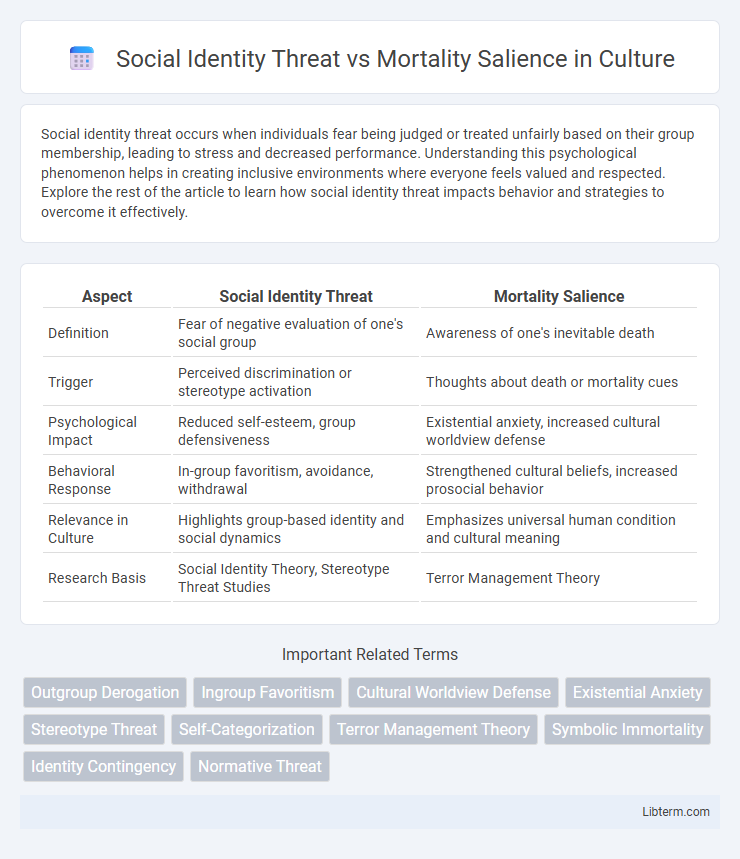Social identity threat occurs when individuals fear being judged or treated unfairly based on their group membership, leading to stress and decreased performance. Understanding this psychological phenomenon helps in creating inclusive environments where everyone feels valued and respected. Explore the rest of the article to learn how social identity threat impacts behavior and strategies to overcome it effectively.
Table of Comparison
| Aspect | Social Identity Threat | Mortality Salience |
|---|---|---|
| Definition | Fear of negative evaluation of one's social group | Awareness of one's inevitable death |
| Trigger | Perceived discrimination or stereotype activation | Thoughts about death or mortality cues |
| Psychological Impact | Reduced self-esteem, group defensiveness | Existential anxiety, increased cultural worldview defense |
| Behavioral Response | In-group favoritism, avoidance, withdrawal | Strengthened cultural beliefs, increased prosocial behavior |
| Relevance in Culture | Highlights group-based identity and social dynamics | Emphasizes universal human condition and cultural meaning |
| Research Basis | Social Identity Theory, Stereotype Threat Studies | Terror Management Theory |
Understanding Social Identity Threat
Social Identity Threat occurs when individuals perceive that their social group is devalued or negatively stereotyped, leading to anxiety and reduced performance in relevant tasks. Understanding Social Identity Threat involves recognizing its impact on self-concept and behavior, particularly under conditions where group membership is made salient or stigmatized. This psychological phenomenon differs from Mortality Salience, which centers on the awareness of one's own death, as Social Identity Threat specifically relates to concerns about social identity and group status.
Defining Mortality Salience
Mortality salience refers to the awareness and cognitive activation of one's own inevitable death, triggering existential anxiety that influences behavior and decision-making. It plays a critical role in terror management theory, which posits that reminders of mortality heighten the need for self-esteem and cultural worldview validation. Unlike social identity threat, which involves threats to one's group identity or social status, mortality salience focuses on the universal personal fear of death and its profound psychological impact.
Key Differences Between Social Identity Threat and Mortality Salience
Social identity threat arises when individuals perceive a risk of being devalued based on their social group membership, leading to anxiety and efforts to protect or affirm their group identity. Mortality salience involves heightened awareness of one's own death, triggering existential anxiety and psychological defenses to manage the fear of nonexistence. Key differences include social identity threat's focus on group-based social evaluation versus mortality salience's focus on personal existential concerns, as well as distinct psychological processes and outcomes related to group dynamics versus individual survival motivations.
Psychological Mechanisms Involved
Social Identity Threat triggers psychological mechanisms such as anxiety and defensive cognition by threatening an individual's self-concept tied to group membership, activating stereotype threat and in-group/out-group dynamics. Mortality Salience invokes Terror Management Theory mechanisms, heightening existential anxiety and prompting symbolic self-esteem defense through cultural worldview reinforcement. Both processes influence behavior by modifying threat perception and motivating coping strategies anchored in identity preservation and meaning-making.
The Role of Group Membership in Social Identity Threat
Social identity threat arises when individuals perceive their group membership is devalued or marginalized, triggering anxiety about group-based identity. This threat influences cognitive and emotional processes, often leading to defensive behaviors aimed at protecting the in-group's status and cohesion. Mortality salience, the awareness of one's own death, can amplify social identity threat by heightening the motivation to defend and affirm group membership as a means of achieving symbolic immortality.
How Mortality Salience Shapes Human Behavior
Mortality salience, the awareness of one's imminent death, profoundly shapes human behavior by triggering existential anxiety that motivates individuals to seek meaning and security through cultural worldviews and self-esteem bolstering. This heightened awareness often leads to increased in-group favoritism, conformity to social norms, and defensive aggression against perceived threats to identity. Unlike social identity threat, which specifically challenges one's social group membership, mortality salience activates deep psychological mechanisms aimed at preserving symbolic immortality and existential significance.
Interactions and Overlaps Between the Two Concepts
Social identity threat and mortality salience interact by activating underlying fears related to self-concept and existential security, often intensifying defensive behaviors aimed at protecting group identity and preserving meaning. Overlaps occur as both phenomena trigger heightened vigilance toward in-group favoritism and out-group derogation, driven by the need to affirm social belonging and counteract existential anxiety. Research indicates that simultaneous exposure to social identity threat and mortality salience amplifies bias expression and group cohesion, highlighting their combined influence on intergroup dynamics and psychological resilience.
Real-World Examples and Case Studies
Social identity threat occurs when individuals perceive their group membership is devalued, such as minority students underperforming in academic settings due to stereotype threat demonstrated in Steele and Aronson's 1995 study. Mortality salience, highlighted in Terror Management Theory, involves heightened awareness of death influencing behavior, exemplified by studies showing increased nationalism and in-group favoritism after reminders of mortality, like those observed post-9/11 in the United States. Both concepts reveal how psychological states drive social behavior, impacting real-world phenomena including workplace dynamics, political attitudes, and intergroup conflicts.
Implications for Social Dynamics and Conflict
Social identity threat triggers defensive group behaviors that escalate intergroup tensions and reinforce in-group favoritism, while mortality salience intensifies existential anxiety, leading to heightened adherence to cultural worldviews and increased out-group hostility. Both mechanisms disrupt social cohesion by amplifying prejudice and exacerbating conflict, particularly in polarized societies where identity and existential fears are intertwined. Understanding these dynamics is crucial for designing interventions that mitigate bias and promote dialogue in diverse social contexts.
Strategies for Coping with Social Identity Threat and Mortality Salience
Coping strategies for social identity threat include affirming personal values, seeking social support from ingroup members, and engaging in collective action to restore a positive group identity. Mortality salience triggers coping mechanisms such as worldview defense, bolstering cultural beliefs, and pursuing symbolic immortality through legacy or meaningful achievements. Both threats benefit from psychological resilience techniques like mindfulness and cognitive reappraisal to reduce anxiety and enhance self-esteem.
Social Identity Threat Infographic

 libterm.com
libterm.com